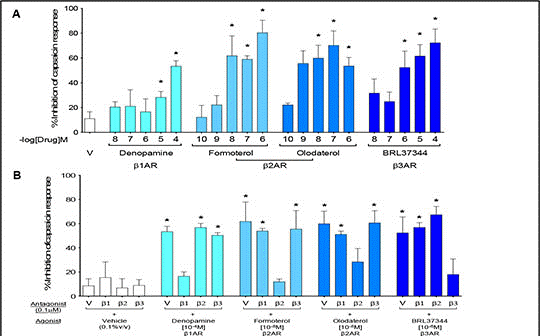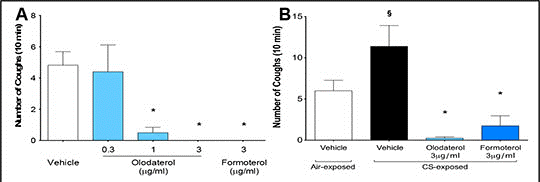Print version
Search Pub Med
An investigation into the anti-tussive properties of β 1 -, β 2 -, and β 3 -adrenoceptor agonists Introduction: Cough is an essential defensive reflex event, however excessive/chronic cough can be a problematic symptom associated with respiratory disease, for which no effective and safe medications are available1. We have previously reported preliminary data showing that short acting β2-adrenoceptor agonists (SABAs), developed as bronchodilators, have anti-tussive activity2. The SABAs blocked capsaicin induced activation of sensory nerves in the vagus (known to contain airway afferent fibres) by opening the paxilline-sensitive BKCa potassium channels and attenuated cough in guinea pigs2. Aims: Investigate the role of other β-receptor subtypes and the more commonly prescribed long-acting β2-adrenoceptor agonists (LABAs), and to assess the effect of LABA’s on specific populations of airway specific afferents in single fibre in vivo electrophysiological experiments and in a ‘disease’ model which exhibits an exaggerated capsaicin-evoked cough phenotype. Methods: Isolated vagus nerve depolarisation was measured as previously described3,4 in tissue harvested from male guinea pigs, wild-type, β2-/- or β3-/- mice, or human donor tissue (unsuitable for transplant). Neurons were isolated from guinea pig jugular ganglia as described previously5; intracellular Ca2+ ([Ca2+]i) and membrane voltage (Vm) changes were assessed using FURA-2 (12µM, 40min incubation, 30min prior to use) and D8-ANNEPS (28nM/10min prior to use). Firing of single airway-innervating C-fibres was measured as previously described6. Capsaicin-evoked (30-60μM) cough was measured in naïve or cigarette-smoke exposed (1 hour twice/day for 8 days) guinea pigs as described previously2 with aerosolised vehicle (0.1% DMSO in PBS) or LABA (0.3-3 μg/ml) administered (10min aerosol), 1h before. Results: Each of the β-agonists caused a concentration-related inhibition of capsaicin-induced vagus nerve depolarisation in guinea pigs (Figure 1A) [non-cumulative concentration-response, n=4]. This inhibition was reversed by only the respective β1-, β2-, or β3-receptor antagonist in guinea pig tissue (figure 1B). In human vagus tissue, capsaicin-induced depolarisation was significantly inhibited by the β1- (denopamine;62.9±6.7%), β2- (formoterol;59.3±9.3%, olodaterol;64.8±11.2%), and β3-agonists (BRL37344;58.7±3.4%) [n=3, p<0.05 - paired t test], with preliminary data showing that the effect is reversed in the presence of respective antagonists (denopamine;-22.6±27.4%, formoterol;-5.9±22.62%, olodaterol;-9.4±1.7%, BRL37344;-22.7±15.6%). Further, LABA and β3-agonist inhibition in wt mice (formoterol;65.8±11.4%, olodaterol;68.2±7.3%, BRL37344;50.5±8.0%) was reduced in β2- (formoterol;11.4±7.7%, olodaterol;-5.9±10.6%) or β3-receptor (BRL37344;0.2±8.3%) knockout mice [n=4-5, p<0.05 - paired t test]. The BKCa channel blocker paxilline at a single concentration (10μM) moderately reduced the β1- (denopamine;53.5±3.5% to 36.9±2.1%), β2- (formoterol;58.2±14.4% to 25.9±5.2%, olodaterol 59.35±8.2% to 29.4±7.7%), or β3-receptor (BRL37344;51.9±10.3% to 15.6±8.5%) agonists inhibition of capsaicin-depolarisation in guinea pig vagus nerve [n=4-5]. Both LABA compounds (0.1nM) inhibited capsaicin-induced [Ca2+]i (Formoterol; 67.6±4.7%, Olodaterol; 70.8±6.4%) and Vm (Formoterol; 77.5±6.8%, Olodaterol; 66.1±8.0%) responses of airway-terminating neurones of jugular-origin [n=4-10 cells, N=3 guinea pigs, p<0.05 - paired t test], as well as capsaicin-evoked firing of single chemosensitive airway-innervating C-fibres in vivo (Formoterol/Olodaterol [3μg/ml,2min] reduced impulse count by 90.2±1.9%/95.6 +/- 2.8% [n=3, P<0.05 - paired t test]. Furthermore, both LABAs significantly inhibited both normal capsaicin-evoked, and smoke-enhanced capsaicin-evoked cough responses (Figure 2). Summary: We show for the first time that agonism of β1- and β3-, as well as β2-receptors, results in inhibition of sensory nerve depolarisation mediated through opening of the BKCa potassium channel. Furthermore, this work indicates a potential use for LABAs as an anti-tussive, beyond their current clinical use.
References: 1. Nasra & Belvisi (2009) Pharmac & Therapeut 124: 2. Freund-Michel (2010) ERJ 35: 3. Patel et al. (2003) BJP 140: 4. Belvisi et al. (2009) BJP 155: 5. Malin et al. (2007) Nat Protoc 2: 6. Adcock et al. (2003) BJP 138

Figure 1. Effect of β-agonists±antagonists on capsaicin-induced vagus depolarisation [A] Concentration response of β1/2/3 agonists inhibition of capsaicin-induced depolarisation, and [B] effect of selective β1/2/3 antagonists on the inhibition of capsaicin-induced depolarisation by a single concentration of β1/2/3 agonists. Both panels; guinea pig vagus nerve tissue, data shown as mean±SEM, * p<0.05, paired t-test compared to internal control, [A] n=4, [B] n=4-5.
Figure 2. Effect of LABA compounds on capsaicin-evoked cough in guinea pigs Effect of aerosolised olodaterol or formoterol (0.3-3μg/ml) on [A] normal or [B] CS-enhanced capsaicin-evoked cough. Mean±SEM, n=6-8, *Kruskal-Wallis, §Mann-Whitney, p<0.05  |



